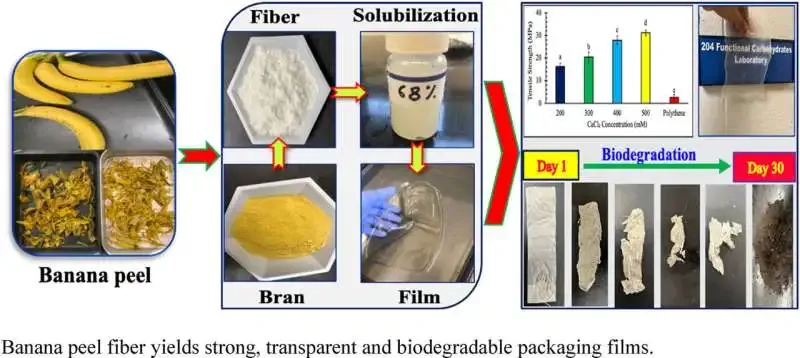Bananas are a fruit that many people like and eat a lot. They are also one of the most grown crops in the world, after rice, wheat and corn. But what does this fruit have to do with the problem of plastic waste?
Plastic waste is a major concern globally due to its environmental impact and threat to human health. However, a promising solution might lie in an unexpected place – banana peels. Researchers have discovered a way to utilize banana peel fiber to create biodegradable films, offering a sustainable alternative to traditional plastics.
Banana peels make eco-friendly plastic
A lot, maybe, says Srinivas Janaswamy, a food chemistry teacher at South Dakota State University. He wrote a study called “Biodegradable packaging films from banana peel fiber” in a science magazine.
“Many of us eat at least one banana a day,” Janaswamy said. “After we eat the fruit, we throw away the peel. What if we could use the peel for something that helps get rid of plastic waste?”
Janaswamy has been studying how to use things like banana and avocado peels to make biodegradable films. These are like plastic materials that can wrap or pack things, but they can break down in nature. One of the biggest problems with plastic made from oil—the most common kind of plastic—is that it does not break down.

For example, plastic things, like plastic bags, will take up to 20 years to break down. People and recycling facilities do not recycle most of the plastic, so it ends up in the trash or nature, where it can harm people and animals. Finding something like plastic that can break down faster would help solve the problem of plastic waste.
“Plastic does not break down and we need to fix its effects on people and nature with a better option,” said Janaswamy. “Banana peels are a good and cheap option.”
Banana Peel solution
Bananas, being one of the most widely grown fruits in the world, create a tremendous amount of byproducts. Banana plantations around the world produce about 220 tons of residue per 2.5 acres. Predominantly lignocellulosic material makes up banana residue, which is the key ingredient to create biodegradable films.
One can extract lignocellulosic fiber from banana peels, which people often discard as waste, and use it to create biodegradable films. These films possess strength, transparency, and biodegradability, making them suitable for various packaging applications.
Janaswamy noted that the robust structure, biodegradability, low density, and non-toxicity of lignocellulosic residue from biowaste make it a viable alternative for making bioplastics. He also mentioned that people almost always leave banana residue – the peel – unused, making it an almost perfect byproduct to use for this work.
“Almost 36 million tons of banana peels are produced every year, with most of them being disposed of as waste,” said Janaswamy. “While creating products like chips, flour, juice, jam, baby food and others from bananas, the food processing industry discards a significant amount of banana peel in landfills. It is critical to find a more practical application for banana peels to provide financial benefits to the agricultural industry and prevent environmental pollution.”
In addition to this, we have increased banana production by 10% between 2010 and 2020, and we expect it to continue growing over the next decade. As the demand for packaged and processed foods increases, we also anticipate an increase in the need for plastic packaging material.
Making biodegradable ‘plastic’ from banana peels
The researchers first made the used peels into a powder using a blender. Then, they did the same thing they did before with avocado peels, coffee grounds and switchgrass. They used a chemical process to get the fiber from the powder. The fiber then went through some steps to make it clean and ready to make a film. After drying, they tested the film to see how it was.
“The films are strong and clear, and more importantly, they break down in 30 days when the soil is moist enough,” Janaswamy said. “This finding shows that we can use banana peel and other fruit waste to make and design ‘plastic’ that can break down and replace the real plastic.”
Clearness is one of the important things about films, because people like to see the food they buy. The films they made in this study were clearer than other films they made from different waste.
The strength and stretchiness of the films can tell us if they can be used to pack food. As Janaswamy says, the films made from banana peel are stronger than the plastic bags we use for groceries.
“Our research using green and reusable chemicals is a good and cheap way to make films that break down and replace the plastic made from oil. This is a good thing for the environment and the economy,” Janaswamy said. More research will try to make the films more flexible and see if they can be made and sold on a large scale.
Keep Reading
Why banana republic is trending in America?
Avocado impact: a healthy fruit but harmful to environment
Clothing fibers main source of microplastic pollution in Ganges: Study
If farmers burn stubble two hour earlier can reduce it’s affect: Study
Saffron: How the world’s most expensive spice is disappearing
Follow Ground Report for Environmental News From India. Connect with us on Facebook, Twitter, Koo App, Instagram, Whatsapp and YouTube. Write us on GReport2018@gmail.com and subscribe our free newsletter.
Don’t forget to check out our climate glossary, it helps in learning difficult environmental terms in simple language.








